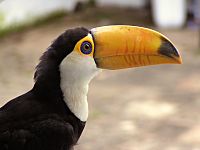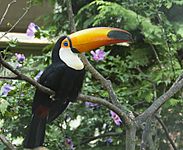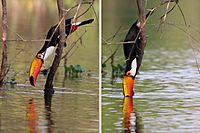Toco toucan facts for kids
Quick facts for kids Toco Toucan |
|
|---|---|
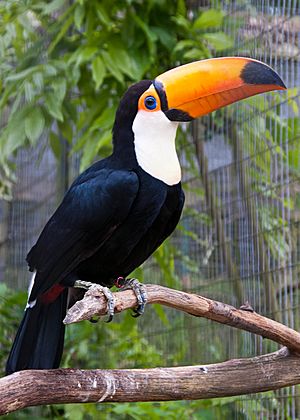 |
|
| Toco Toucan at Birdworld, Surrey, England | |
| Conservation status | |
| Scientific classification | |
| Kingdom: | |
| Phylum: | |
| Class: | |
| Order: | |
| Family: | |
| Genus: |
Ramphastos
|
| Species: |
R. toco
|
| Binomial name | |
| Ramphastos toco Statius Müller, 1776
|
|
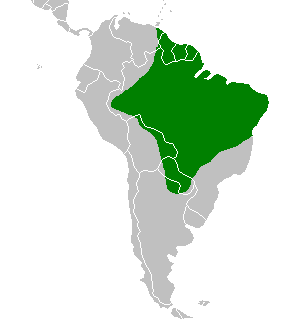 |
|
| Distribution of the Toco Toucan | |
The toco toucan (Ramphastos toco), also known as the common toucan or giant toucan, is the largest and probably the best known species in the toucan family. It is found in semi-open habitats throughout a large part of central and eastern South America. It is a common attraction in zoos.
Contents
Taxonomy and systematics
German zoologist Philipp Ludwig Statius Müller described the toco toucan in 1776.
Subspecies
Two subspecies are recognized:
- R. t. toco - Statius Müller, 1776: Found in the Guianas, northern and north-eastern Brazil and south-eastern Peru
- R. t. albogularis - Cabanis, 1862: Originally described as a separate species. Found in eastern and southern Brazil, northern Bolivia, Paraguay and northern Argentina
Description
The toco toucan has a striking plumage with a mainly black body, a white throat, chest and uppertail-coverts, and red undertail-coverts.
What appears to be a blue iris is actually thin blue skin around the eye. This blue skin is surrounded by another ring of bare, orange skin.
The most noticeable feature, however, is its huge bill, which measures from 15.8 to 23 cm (6+1⁄4 to 9 in) in length, which is yellow-orange, tending to deeper reddish-orange on its lower sections and culmen, and with a black base and large spot on the tip. It looks heavy, but as in other toucans it is relatively light because the inside largely is hollow. The tongue is nearly as long as the bill and very flat.
This species is the largest toucan and the largest representative of the order Piciformes. The total length of the species is 55–65 cm (21+1⁄2–25+1⁄2 in). Body weight in these birds can vary from 500 to 876 g (1 lb 1+5⁄8 oz to 1 lb 14+7⁄8 oz), with males averaging 723 g (1 lb 9+1⁄2 oz) against the smaller female, which averages 576 g (1 lb 4+3⁄8 oz).
Its voice consists of a deep, coarse croaking, often repeated every few seconds. It also has a rattling call and will bill-clack.
The bill is the largest relative to body size of all birds providing 30 to 50% of its body surface area. It's uses could aid in peeling fruit, intimidating other birds when robbing their nests, social selection related to defense of territory, and as a visual warning.
Research has shown that one function is as a surface area for heat exchange. The bill has the ability to modify blood flow and so regulate heat distribution in the body, allowing it to use its bill as a thermal radiator.
In its capacity to remove body heat the bill is comparable to that of elephant ears.
Distribution and habitat
The toco toucan occurs in northern and eastern Bolivia, extreme south-eastern Peru, northern Argentina, eastern and central Paraguay, and eastern and southern Brazil (excluding southern Rio Grande do Sul, the dry regions dominated by Caatinga vegetation and coastal regions between Ceará and Rio de Janeiro). Other disjunct populations occur along the lower Amazon River (Ilha de Marajó west approximately to the Madeira River), far northern Brazil in Roraima, coastal regions of the Guianas and it has been recently registered in north-west Uruguay. It only penetrates the Amazon in relatively open areas (e.g. along rivers). It is resident, but local movements may occur.
It is, unlike the other members of the genus Ramphastos, essentially a non-forest species. It can be found in a wide range of semi-open habitats such as woodland, savanna and other open habitats with scattered trees, Cerrado, plantations, forest-edge, and even wooded gardens. It is mainly a species of lowlands, but occurs up to 1,750 m (5,740 ft) near the Andes in Bolivia. It is easily seen in the Pantanal.
Behaviour and ecology
The toco toucan eats fruit using its bill to pluck them from trees, but also insects, frogs, small reptiles, small birds and their eggs and nestlings. The long bill is useful for reaching things that otherwise would be out-of-reach. It is typically seen in pairs or small groups.
In flight it alternates between a burst of rapid flaps with the relatively short, rounded wings, and gliding.
Nesting is seasonal, but timing differs between regions. The nest is typically placed high in a tree and consists of a cavity, at least part of which is excavated by the parent birds themselves. It has also been recorded nesting in holes in earth-banks and terrestrial termite-nests.
Their reproduction cycle is annual. The female usually lays two to four eggs a few days after mating. The eggs are incubated by both sexes and hatch after 17–18 days. These birds are very protective of themselves and their chicks.
-
Juvenile
Santa Luciana farm, Minas Gerais, Brazil -
Adult
London Zoo -
In flight
Rio Negro, the Pantanal, Brazil -
Drinking
Cuiaba River, the Pantanal, Brazil
Aviculture
Like the keel-billed toucan, the toco toucan is sometimes kept in captivity and has a high fruit diet.
Pet toco toucans must not be permitted to eat mouse (or rat) meat, due to a risk of bacterial infection.
Status
Because it prefers open habitats, the toco toucan is likely to benefit from the widespread deforestation in tropical South America. It has a large range and except in the outer regions of its range, it typically is fairly common. It is therefore considered to be of Least Concern by BirdLife International.
See also
 In Spanish: Tucán toco para niños
In Spanish: Tucán toco para niños



